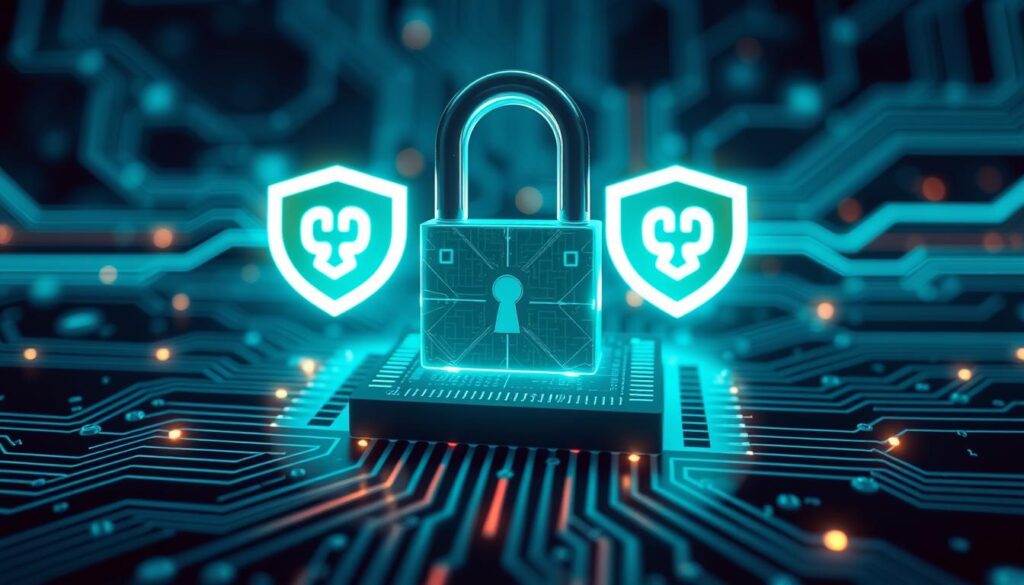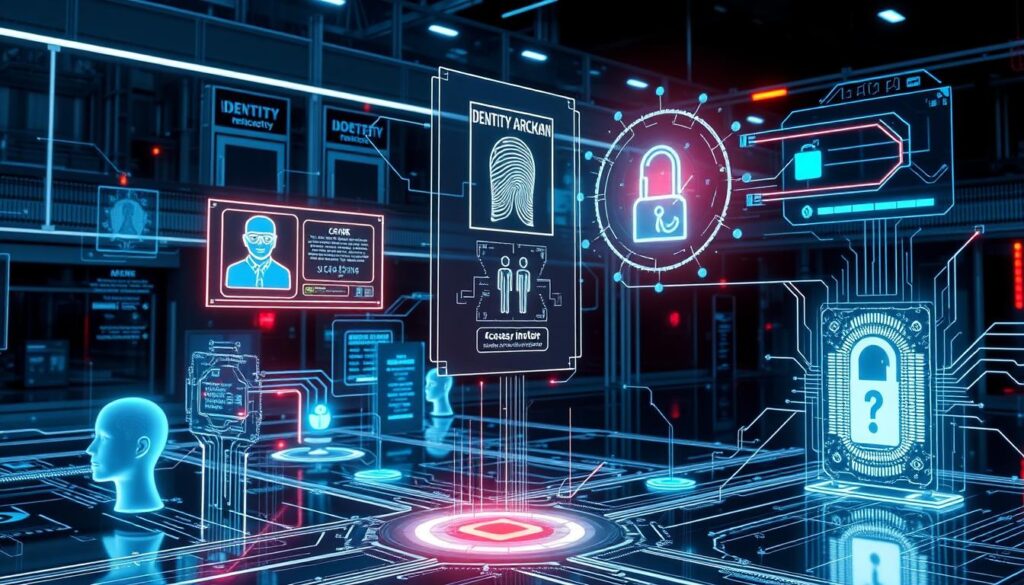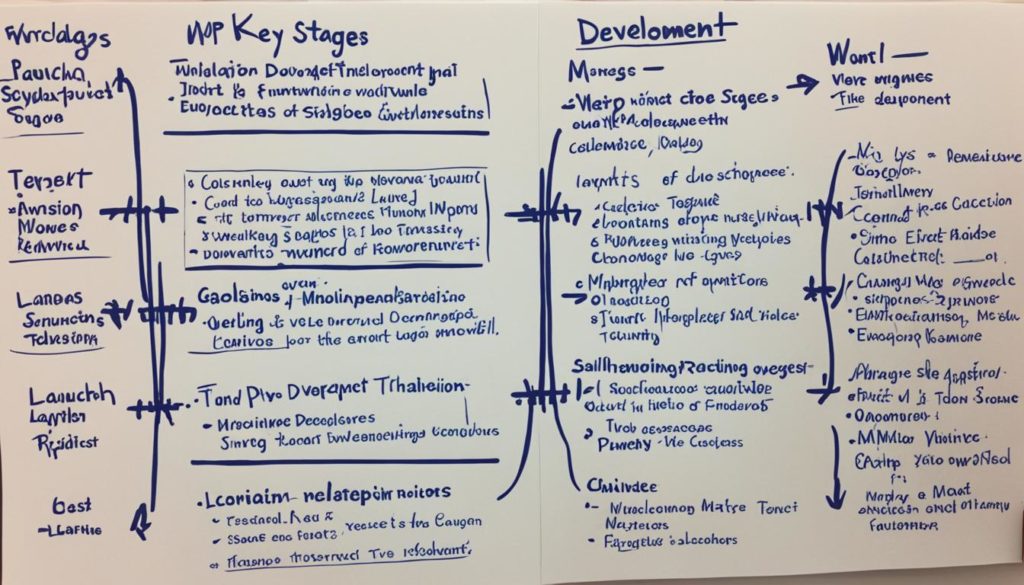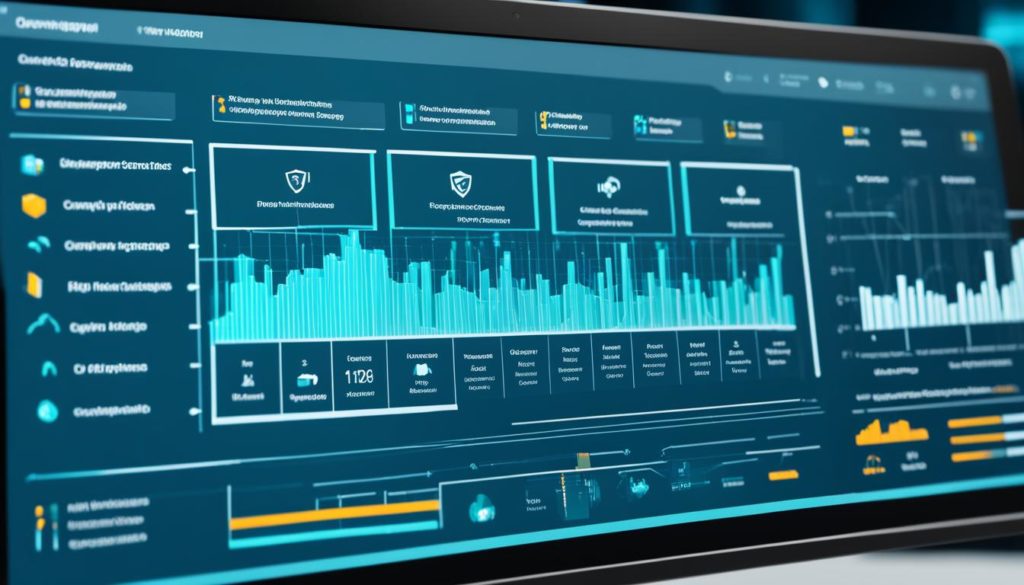
Did you know the average cost of a data breach is over $3 million? This high cost makes Zero Trust security more urgent than ever. Zero Trust architecture (ZTA) has changed how we think about cybersecurity. It moves from old-school defenses to focusing on who and what is doing what.
This new way of thinking has many benefits. It builds trust with customers and opens up new digital business chances.
Cyber threats are getting smarter, making old security models like the castle-and-moat idea outdated. Zero Trust security is all about checking who you are and assuming you might be a threat. This way, it manages risks better.
Getting everyone involved, like CxOs and VPs, is key to making Zero Trust work. It helps everyone understand and support the plan. Big tech companies like Google and Microsoft are already using Zero Trust to keep their online worlds safe.
Key Takeaways
- The average cost of a data breach exceeds $3 million, underscoring the need for robust cybersecurity strategies.
- Zero Trust security centers around identity and behavior-based controls, rather than traditional network defenses.
- Stakeholder engagement is critical for the successful implementation of Zero Trust architectures.
- Leading companies like Google and Microsoft have adopted Zero Trust to protect their digital assets.
- Comprehensive risk assessments help identify critical security issues and prioritize controls investments.
Understanding the Core Principles of Zero Trust Security
Zero Trust Security is all about not trusting anyone or anything by default. It’s about making sure who you let in is clear and known. The Gartner Market Guide to Zero Trust Network Access from June 2020 explains how it works. It checks each request to access data based on who you are, what device you’re using, where you are, and what you’re trying to do.
Zscaler leads in Zero Trust with its Zero Trust Exchange platform. It’s spread across over 150 data centers worldwide. This setup keeps your data safe by limiting who can get to it and where they are.
Starting a Zero Trust security plan means asking two key questions. First, what do you need to protect? Second, from whom do you need protection? Every time someone tries to get to your data, it’s checked thoroughly. This includes looking at who they are, what device they’re using, and how they’re acting. This way, your security keeps up with new threats.
Following standards like PCI DSS and NIST 800-207 makes your data protection stronger. In 2021, the Biden administration made NIST 800-207 the law for U.S. Federal Agencies. This move, along with help from many others, makes Zero Trust a solid choice for businesses.
Zero Trust gives you tight, smart controls over who gets to your data. It fights off threats like ransomware and insider attacks. It keeps an eye on who’s doing what and where they are. This helps make your security even better by using big data and AI.
The table below shows what makes Zero Trust architecture strong:
| Zero Trust Model Principles | Details |
|---|---|
| Identity Verification | Continuous authentication of users and devices |
| Device Compliance | Regularly checking and enforcing device security standards |
| Contextual Access Controls | Access decisions based on user identity, location, and behavior |
| Proximity to Users/Applications | Data centers globally distributed to maintain minimal latency |
| Real-time Monitoring and Analysis | Leveraging telemetry and threat intelligence to adapt security measures |
Securing Identities: The Foundation of Zero Trust
In the world of Zero Trust Security, keeping identities safe is key. By using strong identity checks and multi-factor authentication, companies can boost their defenses. Let’s dive into the main steps to strengthen our strategies:
Strong Authorization Policies
We need to set up solid authorization rules to create a safe space. These rules should cover all types of identities, both human and non-human. By making sure access is only given after clear checks, we lower the risk of unauthorized entry.
These checks include things like user role, where they are, and what device they use. They also look at how sensitive the data is.
Identity Verification Techniques
Using top-notch identity verification methods is crucial in Zero Trust. By checking users through many different ways, we make sure only the right people get in. This stops old ways of logging in, which helps keep security strong.
Multi-factor Authentication
Multi-factor authentication (MFA) is a big part of keeping things safe. With MFA, users must prove who they are in more than one way. This makes it harder for hackers to get into accounts.
Adding in Conditional Access policies makes things even better. These policies change how access works based on real-time checks and risk levels.
| Statistics | Details |
|---|---|
| % increase in the utilization of Zero Trust security model | 50% improvement in access compliance and risk mitigation through strong authentication |
| % reduction in successful attacks due to legacy authentication blocking | 30% |
| % enhancement in user experience due to Single sign-on implementation | 45% |
| % increase in visibility through analytics implementation | 55% |
Endpoint Security: Compliance and Control
As companies move to Zero Trust, endpoint security is key to protecting digital assets. It’s important to make sure all devices meet the company’s security rules before they can access networks and data. We’ll look at how to make sure devices are secure and under control.
Ensuring Device Compliance
In today’s world, many devices are not managed by companies. This leads to different settings and software levels. It makes it easier for cyber threats to find their way in. So, having a strong plan for device compliance is crucial.
To keep devices safe in a Zero Trust setup, we need to have security rules for all devices. This includes making sure devices are secure, their settings are right, and apps are safe. It also means checking if devices and apps are allowed to access data.
- endpoint security
- device configuration
- application protection
- device compliance
- risk posture
First, we need to make sure all devices are linked to cloud identity providers. We should only let compliant devices and apps access data. We also need to stop data loss for both company and personal devices.
Next, we should keep an eye on device risks all the time. We should control access based on how risky a device is.
Unified Endpoint Management
Unified Endpoint Management (UEM) systems are essential for managing and securing company devices. UEM helps make sure devices follow the rules and keeps digital assets safe. It includes tasks like linking devices to Microsoft Entra ID and setting up security policies.
A good endpoint security system also needs to use multi-factor authentication and limit access to what’s needed. It should watch and analyze what devices are doing. Using Windows Hello for Business as a sign-in method is also a good idea.
Recently, 61% of companies had a Zero Trust security plan in 2023, up from 24% in 2021. Phishing and stolen credentials are big threats, often because of weak endpoints. By focusing on endpoint security and device compliance, companies can keep their systems safe.
Network Segmentation for Enhanced Data Protection
Network segmentation is key in modern cybersecurity, especially in Zero Trust frameworks. It divides the network into smaller parts. This limits unauthorized access and reduces attack risks. It greatly improves data protection and helps stop breaches.
Micro-segmentation is a vital strategy in network segmentation. It uses detailed security policies for each application or workload. This method controls network traffic better, improving security. It works in both on-premises and cloud settings, ensuring uniform security.
Zero Trust and network segmentation together offer top-notch protection. Zero Trust trusts no one, using strict access controls and constant monitoring. With network segmentation, it blocks unauthorized access to HPC systems. This keeps sensitive data safe and research integrity intact.
When choosing network segmentation solutions, consider scalability, flexibility, and integration. Solutions that support automation and analytics, like SDN, improve security efficiency. Companies like Nile use Layer 3 segmentation from the start, making security easier and more effective.
Network segmentation is vital in cybersecurity. It’s especially important for government agencies and critical environments. It meets strict regulations by setting boundaries and monitoring network traffic closely. Solutions like Owl Cyber Defense enforce strict data flow controls, keeping networks safe.
Network segmentation with Zero Trust greatly protects data. It checks every access request and isolates segments. This reduces cyber risk and strengthens network integrity. It makes networks more resilient against breaches.
For more on securing HPC environments with Zero Trust and network segmentation, check out this comprehensive guide.
Continuous Monitoring and Risk Assessment
In the world of cybersecurity, keeping an eye on things and checking risks is key. The Zero Trust model checks network and user actions all the time. This helps spot odd behavior and lowers the chance of attacks from inside or outside.
With continuous monitoring, companies can see what’s happening on their networks better. This means they can find threats quicker and stay safer.
Telemetry and Analytics
Telemetry and analytics are crucial for a Zero Trust setup. They give insights into how secure a network is and where it might be weak. By always checking for threats and watching network traffic, companies can act fast when something looks off.
Tools like Azure Sentinel help a lot with this. They give real-time views of security, making sure a strong defense is always in place.
Real-time Threat Protection
Real-time threat protection is at the heart of Zero Trust. It keeps getting better to stay ahead of new dangers. This includes using smart threat detection and being ready to act fast to stop risks.
For example, micro-segmentation helps protect important data. It makes sure only the right people can see it. Using these methods helps companies stay safe and ready for new threats.
To learn more about Zero Trust Security, check out our guide on implementing Zero Trust Security. Keeping an eye on things and protecting against threats all the time will make your data safer.
FAQ
What is Zero Trust Security?
Zero Trust Security is a detailed plan to protect digital spaces. It checks identities, endpoints, networks, data, apps, and infrastructure. It assumes breaches can happen and updates security across all digital areas to manage risks well.
Why is network segmentation important in Zero Trust Security?
Network segmentation is key in Zero Trust. It breaks down networks into smaller parts. This makes it harder for breaches to spread, protecting data and reducing risks.
How does Zero Trust Security protect identities?
Zero Trust Security protects identities with strong rules and checks. It uses Multi-factor Authentication (MFA) to ensure only authorized people get access. This lowers the chance of unauthorized access.
What role does endpoint security play in Zero Trust Security?
Endpoint security makes sure devices follow the organization’s security rules before they can access networks and data. Unified Endpoint Management (UEM) systems manage all corporate devices. This makes following rules easier and helps control digital assets better.
What is the significance of continuous monitoring in Zero Trust Security?
Continuous monitoring is crucial in Zero Trust. It uses advanced tools to watch for threats in real-time. This gives insights into security and vulnerabilities, allowing quick responses to threats and keeping defenses strong.
How does Zero Trust Security enhance device compliance?
Zero Trust Security makes sure devices meet the organization’s security standards. Unified Endpoint Management (UEM) systems help manage this. This makes following rules easier and improves control over digital assets.
What are strong authorization policies in Zero Trust Security?
Strong authorization policies in Zero Trust Security check user credentials in detail. This strict approach ensures access is only granted based on solid security protocols. It helps stop unauthorized access.
Why is real-time threat protection essential in Zero Trust Security?
Real-time threat protection is vital in Zero Trust Security. It allows for quick responses to threats with continuous monitoring and advanced analytics. This proactive approach keeps security dynamic and ready to face threats.
What techniques are used for identity verification in Zero Trust Security?
Identity verification in Zero Trust Security uses Multi-factor Authentication (MFA) and strong authorization policies. These methods ensure user credentials are checked thoroughly. This reduces the risk of unauthorized access and strengthens security overall.
Future App Studios is an award-winning software development & outsourcing company. Our team of experts is ready to craft the solution your company needs.










